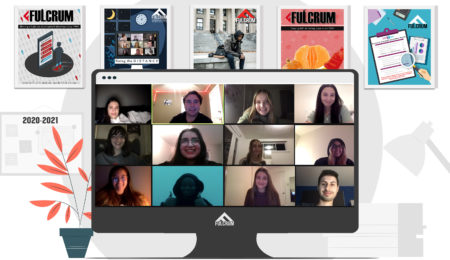Students living in rural or remote areas, have found that working from home may not be an option
In the age of online learning, an area of concern facing students living in rural areas and remote communities is the lack of high speed internet to attend lectures and conduct any form of evaluations.
This presents a systemic issue, as students who work and live in rural communities are faced with poor internet connections, as well as lack of infrastructure.
According to a survey from speedtest.net Canadian average internet speed registers at 62 megabits per second (mbps) but the readings can vary widely from urban to rural regions. In Nunavut, for example, the fastest internet service that can be accessed offers a speed of only 15 mbps. This is lackluster for browsing, let alone studying, and many students are feeling the effects.
Liam Wilford, a fourth-year computer science student from Yellowknife, felt staying at home wouldn’t work sufficiently for his upcoming semester.
“I felt the need to go to Ottawa during the school year, because I did not want to rely on the internet provided in Yellowknife.”
“Some professors do not provide recordings of the lectures, and others are not very tech savvy.”
Valentina Canales Burke, a third-year international development and globalization student has had multiple issues with her internet connection resulting in struggles when it comes to attending a live lecture.
“Living in a rural area means that I often have to deal with my connection cutting out, or being out for hours at a time,” she said.
“This has been an issue during synchronous courses, in particular, especially if the professor doesn’t record the lectures or if in-class participation is a course component.”
Grace Salomonie, a second-year Inuit biochemistry student, felt the same way for the summer term.
“I would have loved the opportunity to do a summer semester, but the internet in Iqaluit is so terrible I would not be able to attend any classes.”
But while the University learning-landscape might look different for students in the age of COVID-19, lack of internet access isn’t a new problem and many programs are hoping to change the dynamic.
Some of these include Connected North and the Indigenous Kids Network of Canada.
Connected North was founded by Cisco and was later taken over by TakingITGlobal (TIG), a non-profit organization founded by Michael Furdyk. The company’s goal is “to use education and technology to really help young people understand and act on challenges and really become actively engaged citizens,” according to Furdyk.
Connect North utilizes low bandwidth televideo services of 1.5 mbps, that allow for students in remote communities to not only have access to high speed internet and computers, but education and resources they may have not had access to before.
“On a daily basis, we’re delivering video based virtual learning to try to help bridge that digital divide, you know, really trying to bring learning experiences to students,” said Furdyk to the Fulcrum.
However, Furdyk notes that when it comes to supplying internet access as well as computers, there is a troubling cost associated with supplying high speed internet to remote communities.
“I think we need to make sure that we as citizens and our government are doing as much as possible to make sure that internet access is almost like a human right.”
When it comes to online learning, Furdyk explained that what might be accessible for some students can be barriers for others.
“When we come up with rules, like you have to be on camera, that can create a lot of barriers, not just for someone in a low bandwidth situation, maybe someone who’s a single parent or someone who asked to, you know, work multiple jobs to pay their tuition,” said Furdyk.
“I would really encourage, working with students from diverse contexts to really understand how they can redesign learning in a way that’s relevant for them.”
“We need to keep hiring professionals or professors that are on the cutting edge. So we’re trying to [find] those skills [in] people who are out in industry and community.”
The Indigenous Kids Network of Canada founded by Emily Fudge in 2019 is another program working to make internet access more accessible across Canada, starting with young students.
It is a non-profit organization aimed at making sure members of Indigenous communities across Canada are connected to Jordan’s Principle, a federal government initiative to ensure that all Indigenous children in Canada have access to services and resources.
“I was inspired because I worked on a reserve for about two and a half years, I just saw all the injustices that were going on there,” said Fudge. “I wanted to help people connect to other services, because there’s a lot of people that want help, and they’re not able to get help in their communities.”
With the onset of the COVID-19 pandemic, Indigenous communities who are already struggling to keep up with the education systems in place throughout the country are set back even further due to the lack of infrastructure.
Fudge explains that students in remote, Indigenous communities were already experiencing a grade gap when compared to students in less remote areas due to the unconventional nature of their education.
Additionally, remote communities usually only have access to one or two general stores where workbooks for school are not available, and office supplies like pencils and glue can cost up to four times more than they would in more populated areas. Tutors and specialized education programs are also limited.
Students who wish to pursue higher education face a multitude of problems. This may include leaving their communities for the first time, which can be a huge change, limited support systems and in some cases, racism.
To specifically combat the limitations that have come with the pandemic, the Indigenous Kids Network of Canada has launched a COVID-19 project using a grant the organization received from the federal government through the Red Cross.
However, for most students living in rural or remote areas, it remains that the lack of high speed internet makes it less than optimal for them to study from home despite the University’s assurances and these programs.
“Despite the school’s assurances of support,” said Wilford “I would not feel comfortable trying to attend school in my hometown of Yellowknife.”





